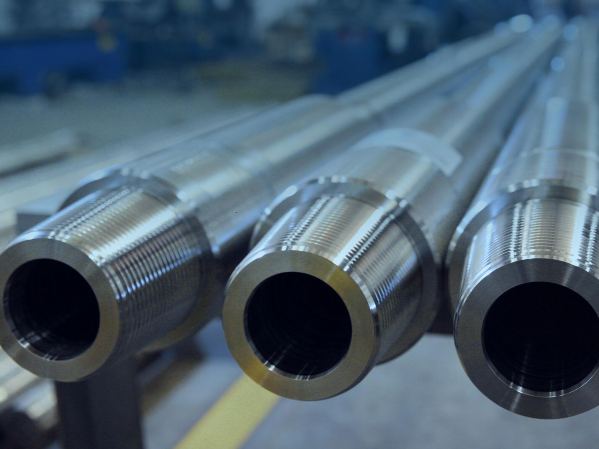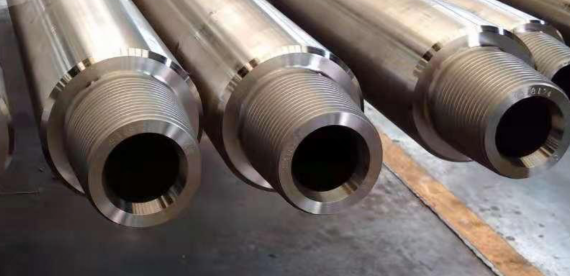What is a drill collar?
The
drill collar is one of the core components of the drill string in oil and gas drilling. It is located at the bottom of the drill string and directly connected to the drill bit. It is mainly used to provide drilling pressure and maintain the stability of the drill string. Its main characteristics are large wall thickness (generally 38~53mm, equivalent to 4~6 times the wall thickness of the
drill pipe), large gravity and rigidity. In order to facilitate the drilling work, the outer surface of the internal thread of the drill collar can be processed with hanging card grooves and slip grooves.
The function of the drill collar:
(1) Apply drilling pressure to the drill bit.
The high weight of the drill collar itself (the weight per unit length is 4~6 times that of the drill pipe) enables the drill bit to effectively break the rock and ensure the drilling depth.
(2) Ensure the necessary strength under compression conditions.
(3) Reduce the vibration, swing, and jump of the drill bit, so that the drill bit works smoothly.
The thick wall structure enhances rigidity and reduces drill bit jump and well deviation, especially in vertical wells.

(4) Control well inclination and assist directional drilling.
In directional drilling operations, the wellbore trajectory is controlled by gravity in conjunction with stabilizers, and is used for horizontal or directional wells.
(5) Optimize drilling fluid flow.
The smaller inner diameter can increase the drilling fluid flow rate and enhance the bottom hole cleaning ability.
Features of drill collars:
1. High weight: The weight per unit length is much greater than the drill pipe (for example, a 6¼" drill collar weighs about 100 lb/ft).
2. Thick wall design: The wall thickness is 3 to 5 times that of the drill pipe, and it has strong bending resistance.
3. High rigidity: Reduce drill string vibration and maintain wellbore verticality.
4. Non-magnetic option: Non-magnetic drill collars (Non-Magnetic DC) is used for logging while drilling (MWD/LWD).
Classification of drill collars:
Drill collars are generally divided into three types: integral drill collars, spiral drill collars, and non-magnetic drill collars.
1. The integral drill collar is a smooth thick-walled round tube with connecting threads processed at both ends, which is suitable for conventional drilling of vertical wells.
2. The spiral drill collar processes three right-hand spiral grooves on the outer cylindrical surface of the round drill collar to reduce the contact area with the well wall, which can effectively prevent the pressure difference from sticking the drill, and is suitable for formations that are easy to stick the drill (such as shale and salt layers).
3. Non-magnetic drill collars are mainly used for monitoring during oil drilling, and their structure is the same as that of integral drill collars. Non-magnetic drill collars are made of N1310 low-carbon alloy steel, which is forged after strict chemical composition analysis. The material has been tested for mechanical properties to ensure that the hardness, toughness, impact value and corrosion resistance meet the standards, and has good low magnetic permeability and good machining performance.
In order to facilitate the work of drilling, it can be The outer surface of the internal thread of the drill collar is processed with hanging grooves and slip grooves. Different types of drill collars (such as spiral drill collars and slip groove drill collars) have additional functions in specific scenarios, such as the spiral structure reduces the risk of drill sticking, and the slip groove design facilitates the rapid installation of lifting equipment.
Drill collar size range:
Outer diameter range:
The common outer diameter range is concentrated between 4 inches and 9 inches, such as 4¾ inches, 6¼ inches, 8 inches, etc. The outer diameter size needs to match the drill bit diameter, which is usually 0.25 inches to 0.5 inches smaller than the drill bit. For example, when using a 12¼-inch drill bit, the outer diameter of the matching drill collar is mostly 11¾ inches.

Length range:
The length of a single drill collar is mostly 30 feet (about 9.1 meters) or 31 feet (about 9.45 meters). In actual use, multiple drill collars are connected to form a combination, and the total length can reach hundreds of meters.
The standard length of the drill collar is 9.1 meters (30 feet). This length design is based on the following considerations:
1. Convenience of transportation and operation: The length of 9.1 meters is convenient for land transportation and hoisting at the well site, while reducing the number of connections and improving drilling efficiency.
2. Optimization of mechanical properties: Longer single drill collars can reduce threaded connection points, reduce the risk of fatigue failure, and improve the overall stability of the drill string.
3. Historical use: Early drilling rig equipment and derrick heights limited the length of drill collars, and 9.1 meters became a widely accepted specification in the industry.
It should be noted that some special working conditions (such as ultra-deep wells or small borehole drilling) may use non-standard length drill collars, such as 4.5 meters or 12 meters, but custom designs and safety assessments are required.
Special specifications:
Customized specifications for non-magnetic drill collars can cover a length range of 1-6 meters, and the outer diameter can reach 16-200 mm.
Key size parameters:
1. Outer diameter (OD) selection principle
Matching wellbore size: The outer diameter of the drill collar is usually 1/10 of the wellbore diameter. 70%~85%, for example: 8½" wellbore usually uses 6¼" drill collar.
Rigidity requirement: The larger the outer diameter, the stronger the bending resistance, and horizontal wells require a larger outer diameter.
2. Inner diameter (ID) design features
Conventional drill collar: smaller inner diameter (2"~3"), increasing drilling fluid flow rate
Non-magnetic drill collar: smaller inner diameter (1½"~2½"), leaving space for instruments
Spiral drill collar: same inner diameter as conventional, with spiral grooves on the outer wall.
Customized sizes may be used for some special working conditions:
Ultra-large outer diameter drill collar: 10"~12" (for 20"+ wellbore)
Ultra-small inner diameter drill collar: ID<1" (for turbine drilling)
Typical applications of drill collars:
1. Vertical well drilling
Provide stable drilling pressure through weight to prevent drill bit bounce.
2. Directional well/horizontal well
Control the wellbore trajectory with stabilizer and downhole motor.
3. Logging while drilling (LWD/MWD)
Non-magnetic drill collars accommodate inclination instruments to avoid magnetic interference.
4. Deep well/ultra-deep well
High-grade steel drill collars (such as Class 3) Withstand extreme loads.
Comparison between drill collar and drill pipe:
Drill collar: The main function is to provide drilling pressure and stabilize the drill string. It is extremely heavy (4 to 6 times the weight of the drill pipe), with extremely thick walls (high rigidity), and is located at the bottom of the drill string.
Drill pipe: The main function is to transmit torque and transport drilling fluid. It is light in weight, thin in wall thickness (flexibility is required), has high rigidity, and is located in the middle and upper part of the drill string.
Conclusion:
Drill collar is the "ballast stone" of drilling operations. Its core value lies in providing drilling pressure and stabilizing the drill string. When selecting, it is necessary to select the appropriate type according to the well depth, well type, and formation characteristics (such as spiral drill collar anti-stuck, non-magnetic drill collar with logging), and strictly follow international general standards (such as API SPEC 7-1) to ensure safety and reliability.



